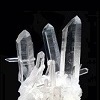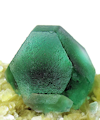| View previous topic :: View next topic |
| Author |
Message |
Tobi
Site Admin

Joined: 07 Apr 2009
Posts: 4255
Location: Germany



|
 Posted: Sep 09, 2018 10:50 Post subject: Re: Tourmaline type question Posted: Sep 09, 2018 10:50 Post subject: Re: Tourmaline type question |
|
|
| Carles Millan wrote: | | jorge santos garcia wrote: | | If not, call it simply tourmaline. |
The venerable Dr. Frederick Pough said something like "Just call it tourmaline. Tourmaline is a perfectly good name. You don't need 15 new names for the same mineral. That is just dumb!". Cited by our beloved Rock Currier in his excellent text "About Mineral Collecting", The Mineralogical Record. Nowadays many people label elbaite without even being sure it is. Me too. |
| Peter Lemkin wrote: | | What Pough and others say is true/correct. Each to their own on this. On my mineral labels, I put Tourmaline (var. xxxxx) and leave it at that. I know the variety is not an approved separate mineral in and of itself - but by color they are <commonly> referred to differently - and even then only with very sophisticated tests can one even know if, how much, and with what minor elements the chemical formula differs - or what is actually causing the color change. |
I agree that a private collector should have the right to label his specimens "the easy way" and not according to mineralogical nomenclature. When a red elbaite, a multi-coloured "water-melon" and a black schorl are all labeled "tourmaline", it may be not very sophisticated - but it is also not wrong. |
|
| Back to top |
|
 |
rweaver
Joined: 13 Apr 2009
Posts: 259
Location: Ridgecrest, California



|
 Posted: Sep 09, 2018 11:08 Post subject: Re: Tourmaline type question Posted: Sep 09, 2018 11:08 Post subject: Re: Tourmaline type question |
|
|
| When one of your mentors was Josie Scripps, calling them anything other then Tourmaline was very very wrong. |
|
| Back to top |
|
 |
basti

Joined: 29 Mar 2012
Posts: 27
Location: Brno, Czech Republic


|
 Posted: Sep 11, 2018 13:49 Post subject: Re: Tourmaline type question Posted: Sep 11, 2018 13:49 Post subject: Re: Tourmaline type question |
|
|
I would really stick to the label "tourmaline" if we want to be scientifically correct, because:
- dravite can be bright green or red
- schorl can be dark green or brown
- pink tourmaline might be elbaite, fluorelbaite, rossmanite, darrellhenryite, liddicoatite, tsilaisite...
- black tourmaline can be dravite, schorl, fluorschorl, foitite...
- one single crystal of "water melon" tourmaline can be in fact more then 5 IMA valid tourmalines...
...
You get the idea, just color is not the good indicator. Especially Li-rich tourmalines can be very variable and tricky.
Do not rely on scientific literature too much as many published papers - especially older then decade - are often incorrect. Previously, the oxy- and fluor- tourmalines were not recognized and even many modern studies do not properly analyze this. You can not be 100 % sure about the formula based solely on EMPA analyses, you also need Raman/IR or LA-ICP-MS or X-ray diffraction...
Tourmaline nomenclature (as well as micas, amphiboles and some other groups) is pretty useless for collectors. Nature can not be split into exactly defined separate "boxes" and tourmaline structure is a "trash can" accommodating very wide range of elements => resulting in dozens of tourmaline group minerals with good immiscibility.
The problem is that just simple black "schorl" crystal from primitive pegmatite might be internally zoned with foitite/magnesiofoitite core, schorl/fluor-schorl mid-zone and dravite rim. These zones can also repeat several times. LCT pegmatites often contain very complex and variable tourmalines where one tourmaline crystal consists of several IMA approved minerals. How do you label this? Like "crystal of dravite-schorl-elbaite-liddicoatite-tsilaisite"? How can you identify these tourmalines without extensive, expensive and often destructive analytical work? |
|
| Back to top |
|
 |
lluis
Joined: 17 Nov 2006
Posts: 719


|
 Posted: Sep 11, 2018 14:29 Post subject: Re: Tourmaline type question Posted: Sep 11, 2018 14:29 Post subject: Re: Tourmaline type question |
|
|
Hi, Basti
And dravite could be also achroic and blue.... as for the black/amber dravites with a colorless portion topped by a blue cap (very nice, besides....)
Rarities in tourmalines are beyond limits....
Personally, I only follow the chemistry(and names associated with it)
I have foitites, analyzed, that could be said schorl....
With best wishes
Lluís |
|
| Back to top |
|
 |
basti

Joined: 29 Mar 2012
Posts: 27
Location: Brno, Czech Republic


|
 Posted: Sep 11, 2018 14:50 Post subject: Re: Tourmaline type question Posted: Sep 11, 2018 14:50 Post subject: Re: Tourmaline type question |
|
|
Sure, it is not definite list, I just used common examples. I have analyzed hundreds of pegmatite tourmalines and I barely scratched the surface of their complexity. Btw. Raman is quite good indicator for tricky V and W positions but nobody did a proper research on that yet.
The other problem is the inconsistency of nomenclature. Some specimens are fluor- or oxy- but some are not named that way. The evolution will probably lead to some kind of semi-systematic nomenclature as was introduced in chemistry for organic compounds - when the growing list of trivial names became too huge and not possible to maintain anymore... |
|
| Back to top |
|
 |
Carles Millan
Site Admin

Joined: 05 May 2007
Posts: 1539
Location: Catalonia



|
 Posted: Sep 12, 2018 05:20 Post subject: Re: Tourmaline type question Posted: Sep 12, 2018 05:20 Post subject: Re: Tourmaline type question |
|
|
Since not all black color tourmalines are schorl, and not all schorls are black, it is nonsense to automatically label all the black tourmalines as schorl. Since not all red/green color tourmalines are elbaite, and not all elbaites are red/green, it is nonsense to automatically label all the red/green tourmalines as elbaite.
Just to be sure, you should have the results of a chemical/physical analysis, which is not the case in most specimens on sale.
Perhaps the best solution would be naming them just tourmaline. It is enough most of the times and is never wrong. |
|
| Back to top |
|
 |
Peter Lemkin
Joined: 18 Nov 2016
Posts: 403
Location: Prague


|
 Posted: Sep 12, 2018 05:22 Post subject: Re: Tourmaline type question Posted: Sep 12, 2018 05:22 Post subject: Re: Tourmaline type question |
|
|
| basti wrote: | I would really stick to the label "tourmaline" if we want to be scientifically correct, because:
- dravite can be bright green or red
- schorl can be dark green or brown
- pink tourmaline might be elbaite, fluorelbaite, rossmanite, darrellhenryite, liddicoatite, tsilaisite...
- black tourmaline can be dravite, schorl, fluorschorl, foitite...
- one single crystal of "water melon" tourmaline can be in fact more then 5 IMA valid tourmalines...
...
You get the idea, just color is not the good indicator. Especially Li-rich tourmalines can be very variable and tricky.
Do not rely on scientific literature too much as many published papers - especially older then decade - are often incorrect. Previously, the oxy- and fluor- tourmalines were not recognized and even many modern studies do not properly analyze this. You can not be 100 % sure about the formula based solely on EMPA analyses, you also need Raman/IR or LA-ICP-MS or X-ray diffraction...
Tourmaline nomenclature (as well as micas, amphiboles and some other groups) is pretty useless for collectors. Nature can not be split into exactly defined separate "boxes" and tourmaline structure is a "trash can" accommodating very wide range of elements => resulting in dozens of tourmaline group minerals with good immiscibility.
The problem is that just simple black "schorl" crystal from primitive pegmatite might be internally zoned with foitite/magnesiofoitite core, schorl/fluor-schorl mid-zone and dravite rim. These zones can also repeat several times. LCT pegmatites often contain very complex and variable tourmalines where one tourmaline crystal consists of several IMA approved minerals. How do you label this? Like "crystal of dravite-schorl-elbaite-liddicoatite-tsilaisite"? How can you identify these tourmalines without extensive, expensive and often destructive analytical work? |
I find your post accurate and scientifically correct. Perhaps someday the price of portable Raman spectrography will be low enough for many of us to have such units. That said, what would be absolutely 'best practice' for a scientific paper or a geology museum might not necessarily be 'logical practice' for a label in a private mineral collection. I do agree it is important for all to KNOW what you write, above, as truth - but, personally, to have a lovely brightly colored tourmaline from Pala, CA or similar next to a common black 'schorl' and have both say only 'Tourmaline' for me, in my collection, would not be/is not my choice. Yes, true, I don't have the equipment nor money to have scientific chemical analyses done (though I try when possible to read technical articles on the minerals from the locations I have) - I would love to have the results of all of them next to the specimens. It is a compromise. On my labels in "quotes" I sometimes even use now totally discarded old names [such as "wood tin"] etc - after the accurate approved name. This despite being a trained scientist - just my way of handling my collection, and not saying anyone else should do so. I TRY to be as scientifically accurate with current approved species name, chemical formula, and other details as I can be [and go into great detail at times on location], but I do add some common [if technically/scientifically wrong] names too. But thank you for this serious, correct and informative post. Again, it is important all know this and make their decisions accordingly. |
|
| Back to top |
|
 |
basti

Joined: 29 Mar 2012
Posts: 27
Location: Brno, Czech Republic


|
 Posted: Sep 12, 2018 06:26 Post subject: Re: Tourmaline type question Posted: Sep 12, 2018 06:26 Post subject: Re: Tourmaline type question |
|
|
I also personally use the "scientifically incorrect" labels, I simply do it best I can. The science is evolving all the time so the labels are never really "finished". if you visit any older museum or collection, you will notice many obsolete or incorrect labels. Some minerals are better analysed, some names are not IMA valid anymore etc.
As an example on tourmalines: All pink Li-tourmalines were previously labelled as rubellite, then it became elbaite (very variable color). Later, we found out that "pink elbaite" is in fact elbaite, fluor-elbaite, rossmanite or darrelhenryite... I suspect it will be even more complicated in 10-15 years :D
To the (portable) Raman spectroscopy: The problem is: 1) the measuring itself, which is not really stupid proof; 2) fitting the measured spectra; 3) referrence DB with verified and high quality spectra. To obtain relevant tourmaline Raman data for referrencing, you have to measure several specimens of each IMA valid tourmaline and you have to do the EMPA or EBSD + LA-ICP-MS + Mössbauer + IR as a minimum for each of these. The situation is even worse because of solid solutions between tourmalines = there are often no pure end members. This would be extremely expensive and time consuming.
I spent lot of time just getting Raman and EMPA data and it is viable way - once you have it confirmed you can identify many tourmalines (maybe all) based solely on Raman spectra. But I have no budget and time to finish such project myself. The other portable-preventing problem is the time - measurement of one good quality spectra easily takes 20-30 minutes as a minimum. |
|
| Back to top |
|
 |
|





